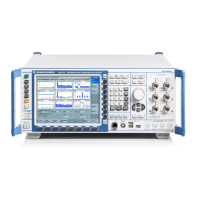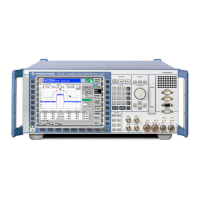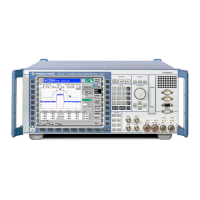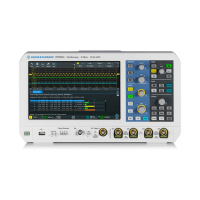System Overview
R&S
®
CMW500
63User Manual 1173.9463.02 ─ 06
in parallel. Some measurement results (e.g. the timing error) require a signaling trig-
ger as a timing reference.
Many measurements provide additional, specific trigger settings to improve their flexibility
and performance.
3.2.6.1 Marker Signals
A marker signal provides events at specific points in time that can be used to synchronize
the measurement. A typical example is a marker signal that is included in the waveform
files generated by R&S WinIQSIM2.
Marker signals can be selected as trigger sources for measurements. The number and
type of available marker signals depends on the installed firmware applications. The
R&S CMW500 detects all available marker signals, depending on its hardware/software
equipment, and adds them to the list of available trigger sources.
3.2.6.2 Trigger Settings
Trigger settings enhance the flexibility of the trigger system and can help to avoid acci-
dental trigger events. The trigger settings depend on the selected trigger source. No
trigger settings apply to most "Free Run" measurements.
The following trigger settings are used in many firmware applications:
●
The "Trigger Slope" setting specifies the edge (rising or falling edge) of the trigger
signal that is to provide the trigger event. This trigger parameter is applicable to power
trigger sources.
●
The "Trigger Threshold" defines the power of the trigger signal where the
R&S CMW500 generates a trigger event. Trigger signals below the trigger threshold
are ignored by the trigger system. This trigger parameter is used for power trigger
sources.
●
A "Trigger Delay" delays the start of the measurement relative to the trigger event.
Typically, a trigger delay is used to compensate for known propagation delays in the
test setup or a known timing offset of the measured signal relative to the trigger signal.
●
A "Trigger Timeout" is the maximum time after which an initiated measurement must
have received a trigger event. If no trigger event is received, a trigger timeout is indi-
cated in manual operation mode. In remote control mode the measurement is auto-
matically stopped.
●
The "Minimum Trigger Gap" defines the minimum duration of the power-down periods
(gaps) between two triggered power pulses. It can be used to prevent unwanted trig-
ger events due to fast power variations.
3.2.7 TX Measurements
The purpose of a TX measurement is to assess the performance of an RF transmitter.
Despite the differences in detail, TX measurements for different network standards have
many properties in common.
Measurements
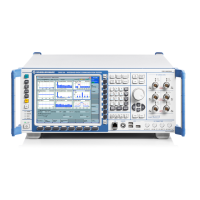
